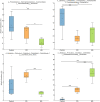Probiotics Bacillus cereus and B. subtilis reshape the intestinal microbiota of Pengze crucian carp (Carassius auratus var. Pengze) fed with high plant protein diets
- PMID: 36337612
- PMCID: PMC9627213
- DOI: 10.3389/fnut.2022.1027641
Probiotics Bacillus cereus and B. subtilis reshape the intestinal microbiota of Pengze crucian carp (Carassius auratus var. Pengze) fed with high plant protein diets
Abstract
The intestinal dysfunction induced by high plant protein diets is frequently observed in farmed fish, and probiotics of Bacillus genus were documented to benefit the intestinal health through the modulation of intestinal microbiota without clearness in its underlying mechanism yet. Fusobacteria, Proteobacteria, and Firmicutes were observed to be the dominate phyla, but their proportion differentiated in the intestinal bacterial community of Pengze crucian carp (Carassius auratus var. Pengze) fed different diets in this study. Dietary supplementation of B. cereus and B. subtilis could reshape the intestinal bacterial community altered by high plant protein diets through a notable reduction in opportunistic pathogen Aeromonas together with an increase in Romboutsia and/or Clostridium_sensu_stricto from Firmicutes. Due to the alteration in the composition of bacterial community, Pengze crucian carp exhibited characteristic ecological networks dominated by cooperative interactions. Nevertheless, the increase in Aeromonas intensified the competition within bacterial communities and reduced the number of specialists within ecological network, contributing to the microbial dysbiosis induced by high plant protein diets. Two probiotics diets promoted the cooperation within the intestinal bacterial community and increased the number of specialists preferred to module hubs, and then further improved the homeostasis of the intestinal microbiota. Microbial dysbiosis lead to microbial dysfunction, and microbial lipopolysaccharide biosynthesis was observed to be elevated in high plant protein diets due to the increase in Aeromonas, gram-negative microbe. Probiotics B. cereus and B. subtilis restored the microbial function by elevating their amino acid and carbohydrate metabolism together with the promotion in the synthesis of primary and secondary bile acids. These results suggested that dietary supplementation of probiotics B. cereus and B. subtilis could restore the homeostasis and functions of intestinal microbiota in Pengze crucian carp fed high plant protein diets.
Keywords: Pengze crucian carp; ecological network; intestinal microbiota; microbial function; plant protein.
Copyright © 2022 Li, Fang, Yi, Kumar and Peng.
Conflict of interest statement
Author XY was employed by Shenzhen Aohua Group Co., Ltd., Shenzhen, China. The remaining authors declare that the research was conducted in the absence of any commercial or financial relationships that could be construed as a potential conflict of interest.
Figures







Similar articles
-
Dietary Antimicrobial Peptides Improve Intestinal Function, Microbial Composition and Oxidative Stress Induced by Aeromonas hydrophila in Pengze Crucian Carp (Carassius auratus var. Pengze).Antioxidants (Basel). 2022 Sep 6;11(9):1756. doi: 10.3390/antiox11091756. Antioxidants (Basel). 2022. PMID: 36139830 Free PMC article.
-
Response of Intestinal Microbiota to the Variation in Diets in Grass Carp (Ctenopharyngodon idella).Metabolites. 2022 Nov 15;12(11):1115. doi: 10.3390/metabo12111115. Metabolites. 2022. PMID: 36422256 Free PMC article.
-
[Karyotypic analysis from two clones of gynogenetic Pengze crucian carp (Carassius auratus of Pengze)].Yi Chuan Xue Bao. 2004 Aug;31(8):780-6. Yi Chuan Xue Bao. 2004. PMID: 15481531 Chinese.
-
Effects of Dietary Administration of Shewanella xiamenensis A-1, Aeromonas veronii A-7, and Bacillus subtilis, Single or Combined, on the Grass Carp (Ctenopharyngodon idella) Intestinal Microbiota.Probiotics Antimicrob Proteins. 2017 Dec;9(4):386-396. doi: 10.1007/s12602-017-9269-7. Probiotics Antimicrob Proteins. 2017. PMID: 28321827
-
The effects of dietary Bacillus cereus QSI-1 on skin mucus proteins profile and immune response in Crucian Carp (Carassius auratus gibelio).Fish Shellfish Immunol. 2019 Jun;89:319-325. doi: 10.1016/j.fsi.2019.04.014. Epub 2019 Apr 7. Fish Shellfish Immunol. 2019. PMID: 30970281
Cited by
-
Dietary Phospholipids and Their Impact on Crustacean Physiology: Growth, Metabolism, Immunity, and Beyond.Aquac Nutr. 2025 Jun 13;2025:8180797. doi: 10.1155/anu/8180797. eCollection 2025. Aquac Nutr. 2025. PMID: 40547201 Free PMC article. Review.
-
Antimicrobial Properties of Bacillus Probiotics as Animal Growth Promoters.Antibiotics (Basel). 2023 Feb 17;12(2):407. doi: 10.3390/antibiotics12020407. Antibiotics (Basel). 2023. PMID: 36830317 Free PMC article.
-
Bacillus subtilis HGCC-1 improves growth performance and liver health via regulating gut microbiota in golden pompano.Anim Microbiome. 2025 Jan 13;7(1):7. doi: 10.1186/s42523-024-00372-x. Anim Microbiome. 2025. PMID: 39806437 Free PMC article.
-
Biological Characterization and Whole-Genome Analysis of Bacillus subtilis MG-1 Isolated from Mink Fecal Samples.Microorganisms. 2023 Nov 21;11(12):2821. doi: 10.3390/microorganisms11122821. Microorganisms. 2023. PMID: 38137965 Free PMC article.
-
Effect of Bacillus velezensis MT9 on Nile Tilapia (Oreochromis Niloticus) Intestinal Microbiota.Microb Ecol. 2025 May 1;88(1):37. doi: 10.1007/s00248-025-02531-2. Microb Ecol. 2025. PMID: 40310547 Free PMC article.
References
-
- Glencross BD, Baily J, Berntssen MH, Hardy R, MacKenzie S, Tocher DR. Risk assessment of the use of alternative animal and plant raw material resources in aquaculture feeds. Rev Aquacult. (2020) 12:703–58. 10.1111/raq.12347 - DOI
-
- Dawood MA. Nutritional immunity of fish intestines: Important insights for sustainable aquaculture. Rev Aquacult. (2021) 13:642–63. 10.1111/raq.12492 - DOI
-
- Zhou Z, Ringø E, Olsen R, Song S. Dietary effects of soybean products on gut microbiota and immunity of aquatic animals: a review. Aquacult Nutr. (2018) 24:644–65. 10.1111/anu.12532 - DOI
LinkOut - more resources
Full Text Sources
Research Materials

